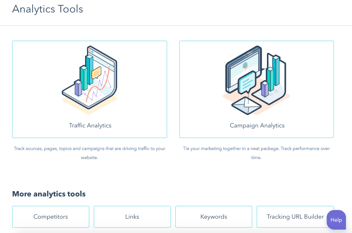
You’ve invested money into your website over the years because you knew that, as a business owner, you need to be represented online. But did you know that you should also be investing some of your time into its performance? Your website can be your company’s number one sales person. It’s always available—24 hours a day, 7 days a week, and it can answer questions as you would for current and potential customers. You can track how your target audience is receiving these answers by tracking these key metrics for your site:
-
Overall website traffic
-
Traffic sources
-
Bounce rate
-
Time on page
-
Conversion rates ( both overall and by source)
-
Top website entry pages
-
Top devices used to access site
-
Growth over time
The metrics we’re suggesting can be found with common website analytic tools like Google Analytics, HubSpot, and Databox.
Overall Website Traffic
Much like body weight, total website traffic is a general metric. It can tell you that you need to make a change but provides little information about how specifically to address problems or how they were caused. Be sure to track this metric over time and look for gradual growth. Watch it over extended periods—preferably over multiple years but at least over a single year—to identify seasonal trends. If your website is newer than this, you can also look for trends by making month-to-month comparisons. The important thing is to gain a sense of your business’ ebb and flow from this data.
Goal:
With website traffic, the goal over time is increase month over month and year over year. Increased website traffic means that more visitors are coming (or returning) to your site, which can lead to more business for you.
Traffic Source
While total traffic may seem like the most important metric, looking at traffic sources can reveal factors that are affecting this number. Website traffic sources reports tell you how a visitor came to your website. Common website sources include
Organic Search Engine Traffic
This represents visitors who navigated to your site after finding your company in unpaid results on search engines like Google, Yahoo, or Bing.
Direct Traffic
This shows you how many visitors typed your URL into their browser’s address bar. These are often returning visitors and staff.
Referral Traffic
This number represents visitors who followed a link your site from another website.
Social Media Traffic
These are visitors who came to your site from your social media posts or business profile pages on platforms like Facebook, LinkedIn, and Twitter.
Paid Traffic
This number tells you how many visitors found your company through your online advertising efforts.
It’s important to understand how people are finding your website without having to ask them, “How did you hear about us?” This will allow you to more easily identify which sources are the best focus for your marketing efforts. The paid traffic source, for example, gives you insight into your return on investment of online advertising dollars.
Goal:
You should try to get a healthy amount of traffic from multiple sources. Keep the individual sources somewhat even. If the majority of your website visitors come from one source—advertising, for example—and you stop running ads, then you’d suffer a dramatic decline in website visitors. If you work on growing each source of traffic independently, you’ll have healthier overall traffic and be able to recover more quickly in the event that it begins to fall off.
Bounce Rate
Your website’s bounce rate is a percentage that shows how many visitors arrive to your site and leave without viewing any other pages.
Goal:
Although it does vary by industry, our recommended goal is to to keep your average bounce rate below 70%. If you’re having difficulty with your bounce rate, start by trying to identify which source of traffic is causing the highest rates and see what you can do to lower it. A great first place to start reducing your bounce rate is to make sure the information on your pages matches the information visitors see on the link they click to navigate to your site. For example, if you’re using advertising to drive website traffic, make sure your ad copy matches the copy on the page you’re sending your visitor.
Time on Page
Like overall website traffic, average time on page is something you want to watch grow over time. There is no single ideal amount of time for visitors to spend on your site, but if you notice the number growing, you can assume people are spending more time learning about your company and services, making it more likely that they will become customers.
Goal:
The goal to increase the amount of time people spend on your site over time. Since this is a general number, be sure to watch it over long spans of time to identify trends.
Conversion Rate (overall and by source)
Conversion rate is the percentage of people who fill out a contact form, becoming leads for your business, compared to the number of people who visited the site. You can view these rates overall, by source, and by page in most tracking tools.
Goal:
Our goal is to maintain an overall average conversion rate of at least 5%. If you see that this number is low, it’s helpful to start by narrowing your insights by source to see which sources show good rates and which need some work. The next thing to look at is CTA placement. A CTA, or call-to-action button, is a standout button or image that asks the visitor to do something like, “Download our guide” or, “Schedule a consultation.” The placement of these buttons should be eye catching but not distracting.
Top Website Entry Pages
A website pages of entry, which Google Analytics calls a “landing page,” is the first page a visitor sees on your site. Most often, this page is your website’s homepage because of the large amount of information most homepages offer.
Goal:
The goal for website entry pages is to try to maintain a low bounce rate and high rates of time spent on the page and conversion to leads.
Top Device Usage
As the world becomes more and more mobile, it’s important to identify what devices your website visitors are using while on your site so you can improve their user experience. Additionally, it’s valuable to look at device usage by source so you can optimize copy on each source for the devices your visitors are using. For example, if the majority of your traffic comes from social media and ads on mobile devices, you’ll want to make sure the copy in your ads or social media posts is concise and the images are a large with minimal text so viewers can easily read and understand them on smaller screens.
Goal:
Top device usage isn’t associated with a goal. Rather, this metric can help you understand how to speak to your audience. Be sure to check this metric periodically and look for changes in trends, and make changes to your strategy as appropriate.
Growth Over Time
Finally, be aware of the growth over time in these and any other key metrics for your website. While it’s important to see what happened last month, it’s also important to see what happened over the last six to twelve months so you can identify any changes or trends that require you to take action. Once you’ve developed these data over time, you can begin to monitor them year over year and identify your company’s seasonal ups and downs.
You can find more information on how to set up Google Analytics here. If you’re interested in more tools to help you look deeper into your website’s health, schedule time with our HubSpot-certified trainer or speak to one of our HubSpot-certified strategists.


